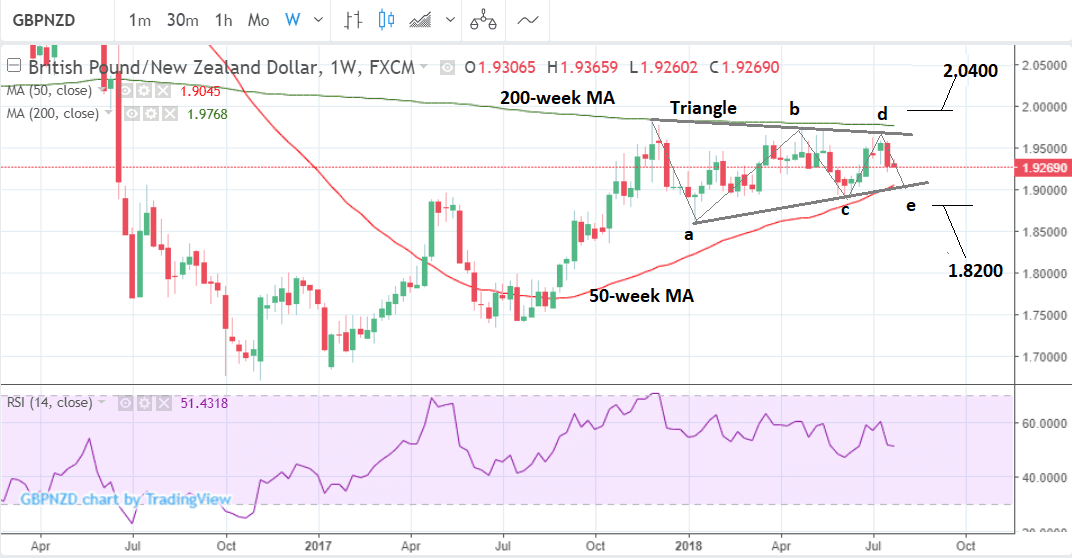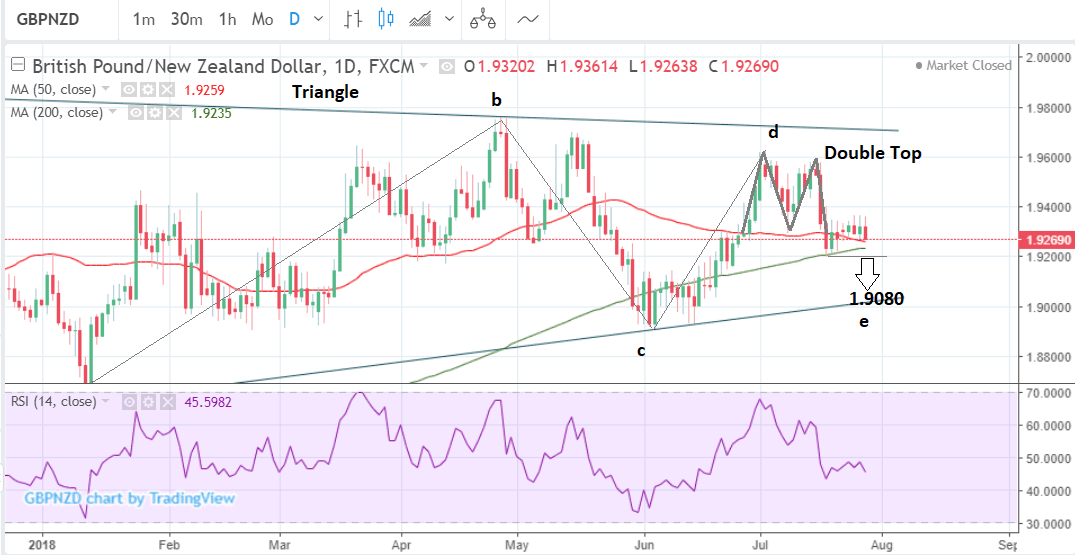Pound-to-New Zealand Dollar Rate in the Week Ahead: Falling After Double Top Formed

Image © Adobe Stock
- GBP/NZD is falling within a triangle pattern in a final wave-e down
- After completion of this wave the pair will probably break out in a volatile move
- The main event for the Pound is the Bank of England meeting; whilst for the New Zealand Dollar it's labour data.
One Pound buys 1.9274 New Zealand Dollars on the interbank market at the time of writing, which is not much different from the 1.9269 close registered at the end of the previous week.
The pair remains trapped in a very tight range in the 1.92-93s. Beyond that it is also trading within a wider range which it has been in since autumn 2017.
The highs and lows of this wider range have tapered into what looks like a triangle pattern, as shown in the chart below.
The triangle is likely to breakout but we don't yet know in which direction.
The fact that the prior trend was up suggests a bias to a breakout higher, but the fact the component waves of the triangle pattern are steeper on the way down than up, suggests underlying weakness, which favours a downside breakout.
There are two possible targets for the breakout, therefore, depending on the direction.
If the exchange rate breaks higher, and manages to exceed the confirmation level at 2.00, then it will probably go all the way up to the target at 2.0400.
If it breaks below 1.8900, on the other hand, the price will probably go all the way down to a target at 1.8200.
The target is generated by extrapolating the height of the triangle by a ratio of 0.618, which is the 'golden ratio', higher.
Zooming in to the daily chart gives a more unambiguously bearish outlook.
The pair has formed a double top reversal pattern at the wave-d highs of the triangle and has broken below the neckline at the base of the pattern, confirming a move lower.
It will now probably move down to a target at 1.9080, calculated by taking the height of the double top and extrapolating it by 0.618 from the neckline. Confirmation would come from a break below the 1.9190 level.
Advertisement
Get up to 5% more foreign exchange by using a specialist provider to get closer to the real market rate and avoid the gaping spreads charged by your bank when providing currency. Learn more here
What to Watch for the New Zealand Dollar
The big release for the Kiwi in the week ahead is employment data, which is forecast to show an unemployment rate of 4.4% and rise in employment of 0.4% in the second quarter, when it is released at 23.45 B.S.T on Tuesday.
A better-than-expected result will probably lead to an appreciation in the Kiwi.
"Note that NZ labour data is extremely volatile and frequently revised," says Imre Speizer at Westpac in Aukland. "Multi-month, we remain bearish given NZ economic growth is slowing," adds the analyst, addressing his bank's stance on the NZ Dollar going forward.
A surprise rise in core inflation last week did however improve sentiment towards the currency, strategist Viraj Patel at ING Bank N.V. made a call for the Kiwi to enjoy a period of "tactical outperformance" on the strength of the data. This is therefore a view to be aware of in the approach to the labour market figures.
Falling unemployment tends to push up wages, and higher wages drive up inflation, which leads to higher interest rates. Higher interest rates tend to support currencies as they attract more inflows of foreign capital seeking somewhere lucrative to park. Thus a strong employment release has the potential to support the Kiwi in its period of 'tactical outperformance' this week.
Key Events to Watch For Sterling this Week
The main event for Sterling on the economic calendar in the week ahead, is the Bank of England policy meeting on Thursday at 11.00 GMT, followed by governor Carney's press conference at 11.30.
The BOE's quarterly inflation report will also be released at the same time.
The current consensus expectation is for the Bank to announce a rise of 0.25% in the base interest rate in the UK to 0.75%.
A hike will probably result in only limited upside for the Pound as the move is already widely telegraphed and lacks the 'element of surprise' for an explosive thrust higher.
The probability of a hike has been hovering at around circa 80%, supported most recently by last week's positive data releases.
Therefore, what will matter is whether the Bank hints at further interest rate rises in coming months. If the Bank strikes a hawkish tone on the matter then Sterling might well extend higher. If the market gets the sense that this is a 'dovish hike' i.e. one that is unlikely to be followed by another rate rise in coming months then the currency might fall.
"We fear that sterling, which has not benefited so far from prospects of tighter monetary policy at home, may suffer," says UniCredit's Mialich, who adds Sterling is damned if the BoE hikes, damned if it does not."
"If the BoE hikes, as we also expect, we would see this as a policy mistake hurting the economy, and thus the currency, over the medium term. If the bank leaves the rate unchanged, investors’ disappointment will likely lead to new GBP sales," says Mialich.
The one spoiler to a rate hike are Brexit risks.
EU chief negotiator Barnier's recent criticisms of key aspects of the Chequer's plan, such as goods' tracking and variable tariffing, make it possible the BOE could opt for caution and not raise rates at all.
"On data grounds a rate rise would seem justified after the weakness in Q1 proved to be temporary, however the uncertainty seen at the end of July might stay the banks hand," says Michael Hewson, analyst at CMC Markets.
Given the heightened expectations of a hike the shock of a no-change is a major risk for Sterling in the week ahead.
The other main data releases for the Pound are Purchasing Manager Survey Indices (PMIs).
The first PMI to be released is manufacturing out on Wednesday at 9.30 B.S.T, which is forecast to show a slide to 54.2 in July from 54.4 in June, although any result above 50 is indicative of growth.
Construction PMI is out on Thursday at the same time and forecast to show a fall to 52.9 from 53.1.
Services PMI is out on Friday at the same time and is expected to show a fall to 54.7 from 55.1.
PMI's are calculated using the answers from surveys of industry purchasing managers who have a pivotal view of conditions. They are seen as an important leading indicator for the economy and, therefore, impact on Sterling, to which they are positively correlated.
Advertisement
Get up to 5% more foreign exchange by using a specialist provider to get closer to the real market rate and avoid the gaping spreads charged by your bank when providing currency. Learn more here





